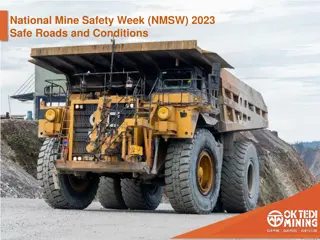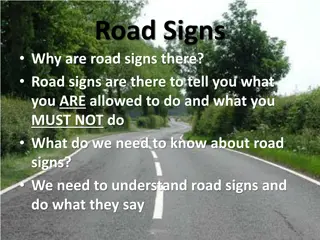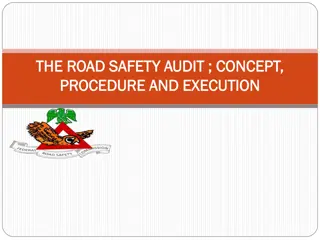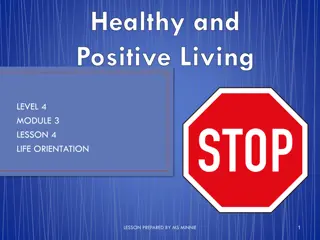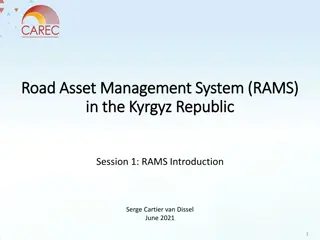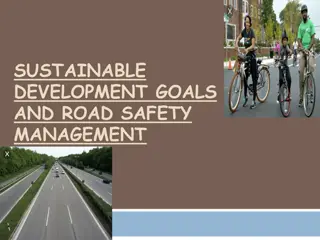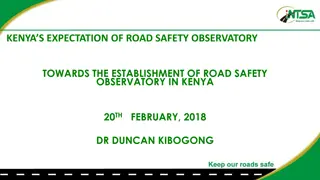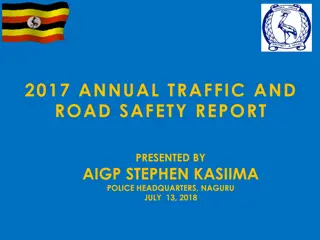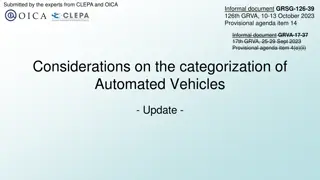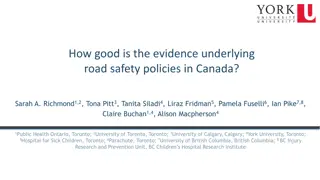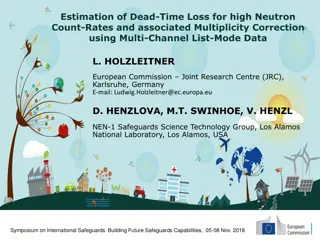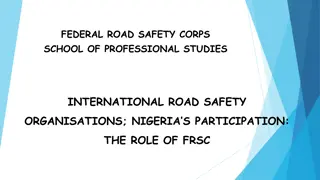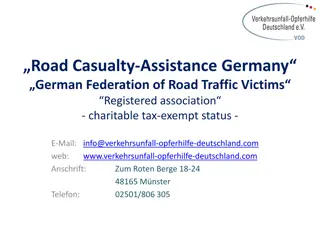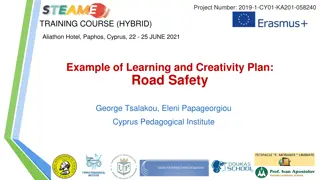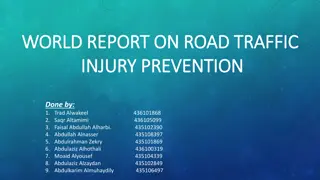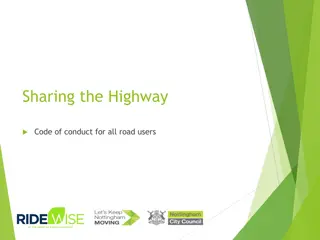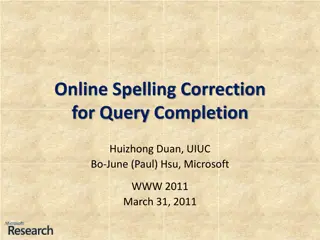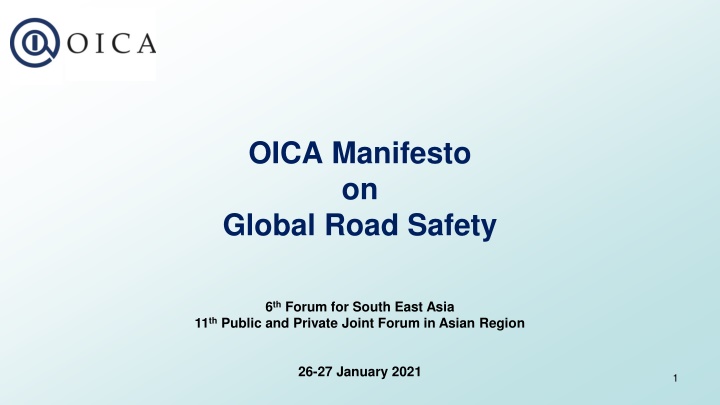
Global Road Safety Manifesto and UN Initiatives for Sustainable Development
Learn about the Organization Internationale des Constructeurs Automobiles (OICA) manifesto on global road safety, the challenges it addresses, and the United Nations' responses to the road safety crisis. Explore the goals set by the UN for reducing road traffic deaths and injuries, as well as the collaborative efforts to promote road safety worldwide.
Download Presentation

Please find below an Image/Link to download the presentation.
The content on the website is provided AS IS for your information and personal use only. It may not be sold, licensed, or shared on other websites without obtaining consent from the author. If you encounter any issues during the download, it is possible that the publisher has removed the file from their server.
You are allowed to download the files provided on this website for personal or commercial use, subject to the condition that they are used lawfully. All files are the property of their respective owners.
The content on the website is provided AS IS for your information and personal use only. It may not be sold, licensed, or shared on other websites without obtaining consent from the author.
E N D
Presentation Transcript
OICA Manifesto on Global Road Safety 6thForum for South East Asia 11thPublic and Private Joint Forum in Asian Region 26-27 January 2021 1
Content 1. What is OICA? 2. Motivation for the OICA manifesto on road safety 3. The OICA manifesto - general principles 4. The OICA manifesto design of new vehicles 5. Conclusion 2
What is OICA ? Organisation Internationale des Constructeurs Automobiles - International Organization of Motor Vehicle Manufacturers World Federation of the National Vehicle Manufacturer Associations Currently 36 members representing all continents All vehicle manufacturers (passenger cars, light and heavy trucks, buses and coaches) via their respective associations Manufacturers provide technical expertise National Associations provide political expertise and local context Global position-taking on global challenges and issues OICA is the voice speaking on automotive issues in world forums officially UN accredited NGO (WP.1, WP.15, WP.29, ) 3
Content 1. What is OICA? 2. Motivation for the OICA manifesto on road safety 3. The OICA manifesto - general principles 4. The OICA manifesto design of new vehicles 5. Conclusion 4
Road Safety is a global challenge 1.3 million deaths every year Leading cause of mortality in low-income and middle-income countries Up to 50 million injuries every year Economically very costly: about 3% of the countries' GDP (source WHO) 5
The United Nations responses to the global road safety challenge United Nations 2030 Agenda for Sustainable Development: 17 Sustainable Development Goals, including road safety Decade of Action for Road Safety 2010-2020 Goal: reduce road traffic deaths and injuries by at least 50 % by 2020 Decade of Action for Road Safety 2021-2030 (UN GA Resolution 74/299 of August 31,2020) Goal: reduce road traffic deaths and injuries by at least 50 % by 2030 6
The United Nations and the integrated approach Increasing recognition that several factors determine road safety All pillars must be considered at the same time in order to find the most effective approach but the road user holds the master key: What is best: a reckless driver in a "safe" car or a careful driver in a car with no fancy technology? What is best: a reckless driver on a "safe" road or a careful driver on an unsafe road? 7
Aggressive NGOs / lobby groups: Focus on the vehicle ! 3 March 2020: " global automakers to make a voluntary commitment to implement the following UN Regulations, by end of 2020: R 94 - Front Impact R 95 - Side Impact R 127 - Pedestrian Protection R 140 - Electronic Stability Control " Manufacturers should commit to voluntarily meet severe safety requirements on the basis of UN Regulations under the 1958 Agreement 8
Content 1. What is OICA? 2. Motivation for the OICA manifesto on road safety 3. The OICA manifesto - general principles 4. The OICA manifesto design of new vehicles 5. Conclusion 9
The OICA manifesto on road safety Integrated / holistic approach no contradictions, no isolation of single factors: Road user Road infrastructure Road traffic rules + enforcement Medical care Understanding accident causation Existing vehicles: age, composition, maintenance, renewal Design of new vehicles Etc. Vehicle manufacturers are directly responsible for the design of new vehicles 10
Safety Innovation in modern vehicles ... Human error is main cause in > 90% of all accidents Industry heavily invests in INNOVATION to avoid/correct human errors and make vehicles safer: Active safety systems (ABS, ESC, ADAS, ...) to avoid accidents or mitigate their impact significantly Passive safety systems (structure, intelligent restraints, ...) to protect when accident does happen 11
But not all vehicles in the world are fully up to date ... Manufacturers agree that Design of new vehicles is one part of the solution to road safety Some vehicle designs still sold in some countries may need to be updated/improved with regard to road safety But manufacturers also consider that a global voluntary commitment (pushed by some NGOs) is not the most efficient approach: No guarantee that all manufacturers will play along Risk of competitive chaos Who will control? Not based on experience gained in many mature markets where minimum needed performance is controlled by authorities/legislation 12
Content 1. What is OICA? 2. Motivation for the OICA manifesto on road safety 3. The OICA manifesto - general principles 4. The OICA manifesto design of new vehicles 5. Conclusion 13
OICA solution to positively influence vehicle design Minimum legal safety requirements in all markets Based on international regulations (UN Regulations under the 58 Agreement or Global Technical Regulations under the 98 Agreement) or Other, well established and recognised requirements as acceptable alternative In depth consultation with all involved in order to determine: Exact content Timing OICA manifesto: proposed list of requirements and their introduction timing for further consideration, based on manufacturers' suggestions Local adaptations possible or even needed 14
Benefits of vehicle legislation approach Level playing field for all vehicle manufacturers: Legal requirements equally apply to all Legal requirements are the minimum to be met: all manufacturers retain flexibility Ensures free, open and fair competition Control procedures based on international experience Legal certainty for all citizens to be better protected Competitiveness of local industry: Internationally recognised standards have the potential to facilitate export and trade 15
Factors to be considered when introducing vehicle legislation Need to assess local situation first in a joint effort with local industry: Understanding the accident causation and its consequences Technical feasibility and Cost/Benefit Ensure fair and adequate treatment to all actors no disruption of supply chain Lead-time Local logistics/administration Etc. Harmonisation/Coordination: no specific national requirements No cherry-picking among the various sets of regulation Possibly foresee gradual and incremental application: No need to go straight to most severe levels of latest international regulations Avoid slowing down fleet renewal 16
Possible minimum vehicle safety requirements for national/regional consideration Light Vehicles Brakes incl. mandatory ABS installation ESC mandatory installation Safety belt anchorages & safety belts Heavy Vehicles Brakes, incl. mandatory ABS installation Safety belt anchorages & safety belts Seat strength & Head Restraints Frontal & Lateral Collision Certified Tyres Safety Glazing Installation of Lighting Certified Tires Safety Glazing Installation of Lighting Mirrors All based on UN Regulations or equivalent standards considered by manufacturers as technically feasible, including appropriate introduction timing For more details: see Manifesto Suggested starting point, for local adaptation and implementation 17
UN Resolution 74/299 31 August 2020 Improving global road safety Encourages Member States ... to consider becoming contracting parties to the UN legal instruments on road safety (e.g. 1958 and 1998 Agreements) and ... implementing and promoting their provisions or safety regulations (Paragraphs 7-8) 18
Conclusion Global Road Safety is a complex issue, involving a combination of various factors and stakeholders, interacting with each other Only an integrated approach can provide an efficient solution Design of new vehicles is not the complete answer but is part of the equation Improvements to vehicle design, where needed, via legislation: Level playing field for all actors Free and open competition 58 & 98 Agreements requirements (or equivalent) provide useful content for national/regional legislation all countries should consider accession OICA Manifesto provides a first basis for further discussions at national/regional level (content and implementation timing) OICA experts happy to help local government and local associations with more info on the UN requirements 19
Thank you for your kind attention Visit our website on: http:// www.oica.net For questions: yvanderstraaten@oica.net 20

